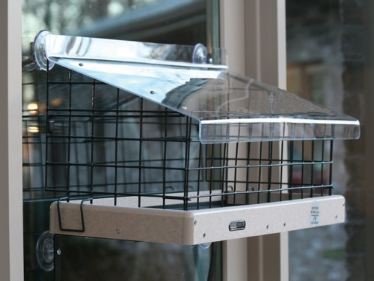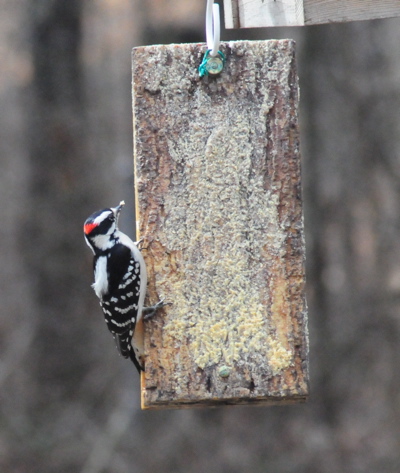-
Get Ready, Get Set, Count! GBBC 2012
It’s the Great Backyard Bird Count!
Feb. 17-20, 2012. Submit your list for US and Canadian locations. Great birding prizes given away too!
Around the third week in February, backyard birding fanatics from novice to seasoned professional, and young to old, will join forces with Audubon and Cornell Lab’s Great Backyard Bird Count. You can participate in this critical citizen science project in just five easy steps (from Zach Slavin in Cornell’s Education & Nature Centers program. Their most helpful hint: “you can even participate in your pajamas“.
Check out Cornell Lab’s Instructional Video (at the end of page) or the easy list below.
1. Make a plan: You’ll need to count birds for a minimum of 15 minutes on one of the count days, but you can count all four days, and you can count for as long as you want. More counting = more data to show us where the birds are.
2. Know your place: Decide whether your count is a STATIONARY COUNT, like watching a feeder out the window, or a TRAVELING COUNT, such as birding during a hike. Print out a data form so that you’ll know what information to record, and a regional bird checklist to help with identification.
3. Count: Record the highest number of each species seen together at one time in stationary counts. For traveling counts, record the total number of individual birds of each species you see during the walk. For more info, visit http://www.birdsource.org/gbbc/howto.html.
4. Report: Enter your findings through the website by clicking on “Enter Your Checklists!” and following instructions.
5. Spread the word: Tell others about your experience. Find out how to be a GBBC ambassador by clicking “Get Involved” on the website. Also, join the GBBC Facebook group, and tweet about the count (use #GBBC when tweeting).
Ready to start? Go to www.birdsource.org/gbbc/ for everything you need.
Happy counting! -
window bird feeders to foil squirrels
So you’d like to see feathered friends close up, but those darn squirrels always seem to find your window bird feeders! It’s an easy enough target, shimmy right on up that wall and the feast is right there for the taking. And the problem is that once they zoom in on the prize – forget it! Your seed’s a goner no matter how much is put out for the birds.
Enter this nifty little accessory, the cage by BirdsChoice. The powder coat metal grid will keep larger and bully birds out, while also denying squirrels access to the seed. Get your chickadees, titmice, buntings, finches nuthatches, and more… close-up and personal!
Appearances might have it that the feeder seems too big or heavy to be stuck on the window-nonsense! Because of an innovative bracing system, and super strong suction cups, these window bird feeders are the bomb! The base is done in recycled plastic, which means it will never warp, split, crack, or fade. The non-porous surface not only makes cleaning a snap, but it helps prevent the spread of disease, as harmful bacteria can not penetrate its surface.
Filling this window bird feeder? Simple! Just lift the lid on the acrylic cover to fill with your favorite seed mix. These new window bird feeders come in two sizes, with the larger tray measuring a whopping 22 inches by 9 inches, that’s some major real estate at the window! The smaller tray (still a generous size for a window feeder) measures 11 x 10 inches. The cages and acrylic covers are relevant and proportional to each size feeder. No “one size fits all” with these high quality window bird feeders, they’re perfect for small yards or no yards at all.
-
peanut bird feeders in winter (and peanut butter)
In our backyard there are more than enough bird feeders which accommodate many species! But when a cool feeder comes along… well, sometimes ya just can’t resist.
Although the woodpeckers, nuthatches, jays and more have they’re own peanut bird feeders, we’ve found that peanut butter is also huge hit in frigid weather. And it doesn’t require a fancy feeder, or any kind feeder at all!
This innovative woodpecker feeder actually holds suet slices in between the two resin, “bark-like” panels, thus the name Suet Sandwich Feeder. On really cold days, we’ll smear peanut butter on the the outer panels as an added bonus, and the birds love it!
With the same idea, peanut butter is also fed to squirrels – smeared right on a few tree trunks in the very back of the yard. It definitely keeps them occupied and they love it too, in fact the squirrels fight over it! Loaded with fat and protein, peanut butter packs in extra calories for furry and feathered friends alike. The calories are converted to energy which help them stay warm in freezing temperatures.
Several types of common feeders may be turned into peanut bird feeders for cold weather. A standard suet cage works great for whole peanuts, platforms and dish feeders will accommodate shelled or whole peanuts, and many hoppers will take a seed mix with peanuts added to it.
Change up the ho-hum feeding routine this winter by offering peanuts or peanut butter to your beaked buddies. You won’t even need a peanut bird feeder to do it!



